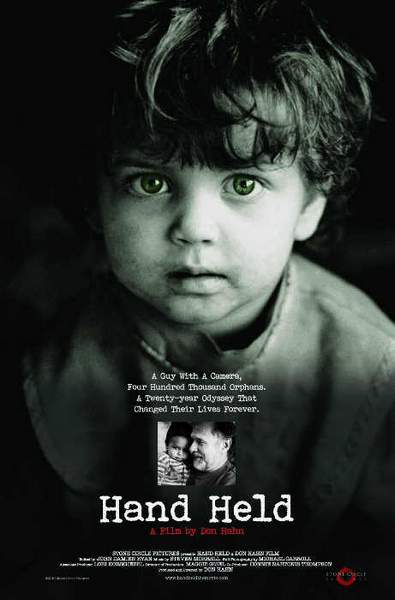
We attended the European premier of "Hand Held," a documentary about Mike Carroll, the Boston Globe photographer who brought the Romanian children's AIDS epidemic to light, then founded a non-profit to help the abandoned children of Romania. It is a documentary directed by Don Hahn, the producer of The Lion King and Beauty and the Beast. It's got Oscar buzz, so watch for it to come out at your local art-flick theatre.
We had breakfast with Mike Carroll, who was staying at our hotel. We had already decided to attend the screening based on a poster we had seen. He is a sincere, down-to-earth kind of guy. He invited us to visit their operations next week in Bistriza, a town about two hours from Cluj.
Movie Trailer: Hand Held
The most compelling scene of the movie for me was Mike talking about becoming emotionally attached to a young boy, about 18 months old. Usually, as he explains, the camera creates some emotional distance, a necessary part of covering difficult subjects. However, after shooting at one orphanage, this boy caught his attention and he stared playing with him. For several days, when he finished shooting at this hospital he returned to play with the boy. He talked with his wife about adoption, and they decided to pursue it. When he returned to the hospital the next day, the boy was not there. The nurse explained that he had tested positive for AIDS and was moved to another hospital. When Don went to the other hospital they had no record of the child; even if he had located him, the US government would not allow an international adoption of a HIV+ child.
Here's the history behind the movie: Romania's Dictator Nicolae Ceauşescu (Tchow-chesk-you) was deposed and killed on Christmas day, 1989. The Berlin Wall fell in November, 1989, and Gorbachev's policies of
glasnost (political openness that led to Soviet media reporting critical stories about the government) and
perestroika (a political restructuring that decentralized the economic control and led to economic crisis) led to the dissolution of the USSR in 1991.
During the 70s and 80s, Ceauşescu saw building factories to export manufactured goods as the key to Romania's future. He uprooted the rural, agricultural population and moved them to the cities to work in factories. The classic Communist block buildings were a symbol of the forced urbanization of the population and the massive building campaigns. The officials in charge of building these buildings figured that the peasants didn't have running water or sewer where they came from, so why should they build that into the 10 story buildings? As a result, people used the stairwells for their toilet, so disease was rampant in the cities.
Ceauşescu couldn't bring enough peasants from the countryside to work in all the factories he wanted to build. So he implemented what
Newsweek called "overplanned parenthood," a scheme to increase the Romanian population by making pregnancy a state policy; childlessness was considered "desertion." Each family was expected to have at least five children. Gynecologists were sent into the factories monthly to conduct unannounced gynecological screenings, ostensibly to check for cervical cancer, but also to report any pregnant women to State Security (called the "menstrual police"). Women who couldn't have children were docked part of their monthly wage as a penalty.
Massive food shortages at the time, the Ministry of Health recommended 1,000 calorie/day as a healthy diet, and diseased conditions among the poorest workers insured a high percentage of low birth weight babies with many complications. Many poor women, who had children at home to take care of, would have to choose between caring for the sick newborn or the healthier toddlers. So many families left their newborns at the hospital where they were at least fed, clothed, and sheltered. This spawned the nationwide chain of orphanages, where the children were warehoused in deplorable conditions.
To address the food shortages and malnutrition of the children in orphanages, someone thought it would be a good idea to use blood transfusions as a source of nutrition. To insure a steady source of "donated" blood, soldiers and aailors were required to give blood twice a year. The Romanian military was active in Angola, Romania's largest trade partner at the time, and brought the AIDS infection home with them. The forced blood donations that were used for the orphanages created the Romanian AIDS epidemic.
In addition, Ceauşescu closed all the nursing schools, as the only thing nurses did was what the doctors told them to do. So why do they need to go to school to learn how to follow orders? Public health nurses were issued two syringes per year, which they used for the mandatory immunization program. So in addition to those in the orphanages, children in healthy families contracted AIDS and Hepatitis as well. Children sick with these diseases were quarantined in special hospitals, which in reality were death wards.
As a result, there is a whole generation of children with AIDS in Romania, who are now young adults. There are many Romanian NGOs (non-governmental organizations) to serve the needs of these people. They maintain their health by participating in large scale clinical trials of the newest AIDS drugs.
I interviewed representatives and beneficiaries from one such NGO in our region. The term they use to refer to themselves has a wonderful ambiguity in translation, "I am a positive person." And they went on to talk about how they take one day at a time, making the most of each good day, because you don't know when the bad days will come. Good advice for the rest of us.












